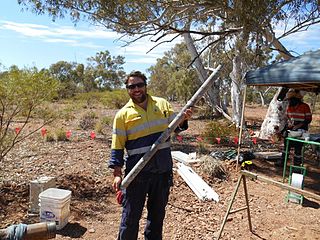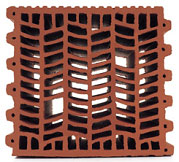
Geotechnical engineering, also known as geotechnics, is the branch of civil engineering concerned with the engineering behavior of earth materials. It uses the principles of soil mechanics and rock mechanics to solve its engineering problems. It also relies on knowledge of geology, hydrology, geophysics, and other related sciences.
Limit State Design (LSD), also known as Load And Resistance Factor Design (LRFD), refers to a design method used in structural engineering. A limit state is a condition of a structure beyond which it no longer fulfills the relevant design criteria. The condition may refer to a degree of loading or other actions on the structure, while the criteria refer to structural integrity, fitness for use, durability or other design requirements. A structure designed by LSD is proportioned to sustain all actions likely to occur during its design life, and to remain fit for use, with an appropriate level of reliability for each limit state. Building codes based on LSD implicitly define the appropriate levels of reliability by their prescriptions.

In engineering, a foundation is the element of a structure which connects it to the ground or more rarely, water, transferring loads from the structure to the ground. Foundations are generally considered either shallow or deep. Foundation engineering is the application of soil mechanics and rock mechanics in the design of foundation elements of structures.

Engineering geology is the application of geology to engineering study for the purpose of assuring that the geological factors regarding the location, design, construction, operation and maintenance of engineering works are recognized and accounted for. Engineering geologists provide geological and geotechnical recommendations, analysis, and design associated with human development and various types of structures. The realm of the engineering geologist is essentially in the area of earth-structure interactions, or investigation of how the earth or earth processes impact human made structures and human activities.
BS 8110 is a withdrawn British Standard for the design and construction of reinforced and prestressed concrete structures. It is based on limit state design principles. Although used for most civil engineering and building structures, bridges and water-retaining structures are covered by separate standards . The relevant committee of the British Standards Institute considers that there is no need to support BS 8110.

The Eurocodes are the ten European standards specifying how structural design should be conducted within the European Union (EU). These were developed by the European Committee for Standardization upon the request of the European Commission.
BS 5930:2015, "the code of practice for site investigations", is a UK code of practice which came into effect on 31 July 2015 British Standards Institution.
BS 5400 was a British Standard code of practice for the design and construction of steel, concrete and composite bridges. It was applicable to highway, railway and pedestrian bridges. It has now been replaced by the European standard, BS EN 1991-2_2003 and other Eurocodes for the design of steel and concrete structures.

In the Eurocode series of European standards (EN) related to construction, Eurocode 2: Design of concrete structures specifies technical rules for the design of concrete, reinforced concrete and prestressed concrete structures, using the limit state design philosophy. It was approved by the European Committee for Standardization (CEN) on 16 April 2004 to enable designers across Europe to practice in any country that adopts the code.

In the Eurocode series of European standards (EN) related to construction, Eurocode 3: Design of steel structures describes how to design steel structures, using the limit state design philosophy.

In the Eurocode series of European standards (EN) related to construction, Eurocode: Basis of structural design establishes the basis that sets out the way to use Eurocodes for structural design. Eurocode 0 establishes Principles and requirements for the safety, serviceability and durability of structures, describes the basis for their design and verification and gives guidelines for related aspects of structural reliability. Eurocode 0 is intended to be used in conjunction with EN 1991 to EN 1999 for the structural design of buildings and civil engineering works, including geotechnical aspects, structural fire design, situations involving earthquakes, execution and temporary structures.

In the Eurocode series of European standards (EN) related to construction, Eurocode 1: Actions on structures describes how to design load-bearing structures. It includes characteristic values for various types of loads and densities for all materials which are likely to be used in construction.
Performance-Based Building Design is an approach to the design of any complexity of building, from single-detached homes up to and including high-rise apartments and office buildings. A building constructed in this way is required to meet certain measurable or predictable performance requirements, such as energy efficiency or seismic load, without a specific prescribed method by which to attain those requirements. This is in contrast to traditional prescribed building codes, which mandate specific construction practises, such as stud size and distance between studs in wooden frame construction. Such an approach provides the freedom to develop tools and methods to evaluate the entire life cycle of the building process, from the business dealings, to procurement, through construction and the evaluation of results.

In the Eurocode series of European standards (EN) related to construction, Eurocode 4: Design of composite steel and concrete structures describes how to design of composite structures, using the limit state design philosophy. It was approved by the European Committee for Standardization (CEN) on 4 November 2004. Eurocode 4 is divided in two parts EN 1994-1 and EN 1994-2.

In the Eurocode series of European standards (EN) related to construction, Eurocode 8: Design of structures for earthquake resistance describes how to design structures in seismic zone, using the limit state design philosophy. It was approved by the European Committee for Standardization (CEN) on 23 April 2004. Its purpose is to ensure that in the event of earthquakes:

In the Eurocode series of European standards (EN) related to construction, Eurocode 9: Design of aluminium structures describes how to design aluminium alloy structures. It complies with the principles and requirements for the safety and serviceability of structures, the basis of their design and verification that are given in EN 1990 – Basis of structural design. It sets requirements for structural integrity, including strength, serviceability, durability and fire resistance.

In the Eurocode series of European standards (EN) related to construction, Eurocode 5: Design of timber structures describes how to design buildings and civil engineering works in timber, using the limit state design philosophy. It was approved by the European Committee for Standardization (CEN) on 16 April 2004. It applies for civil engineering works from solid timber, sawn, planned or in pole form, glued laminated timber or wood-based structural products, or wood-based panels jointed together with adhesives or mechanical fasteners and is divided into the following parts.

In the Eurocode series of European standards (EN) related to construction, Eurocode 6: Design of masonry structures describes how to design buildings and civil engineering works, or parts thereof, in unreinforced, reinforced, prestressed and confined masonry, using the limit state design philosophy. It was approved by the European Committee for Standardization (CEN) on 23 June 2005.

The infill wall is the supported wall that closes the perimeter of a building constructed with a three-dimensional framework structure. Therefore, the structural frame ensures the bearing function, whereas the infill wall serves to separate inner and outer space, filling up the boxes of the outer frames. The infill wall has the unique static function to bear its own weight. The infill wall is an external vertical opaque type of closure. With respect to other categories of wall, the infill wall differs from the partition that serves to separate two interior spaces, yet also non-load bearing, and from the load bearing wall. The latter performs the same functions of the infill wall, hygro-thermically and acoustically, but performs static functions too.














